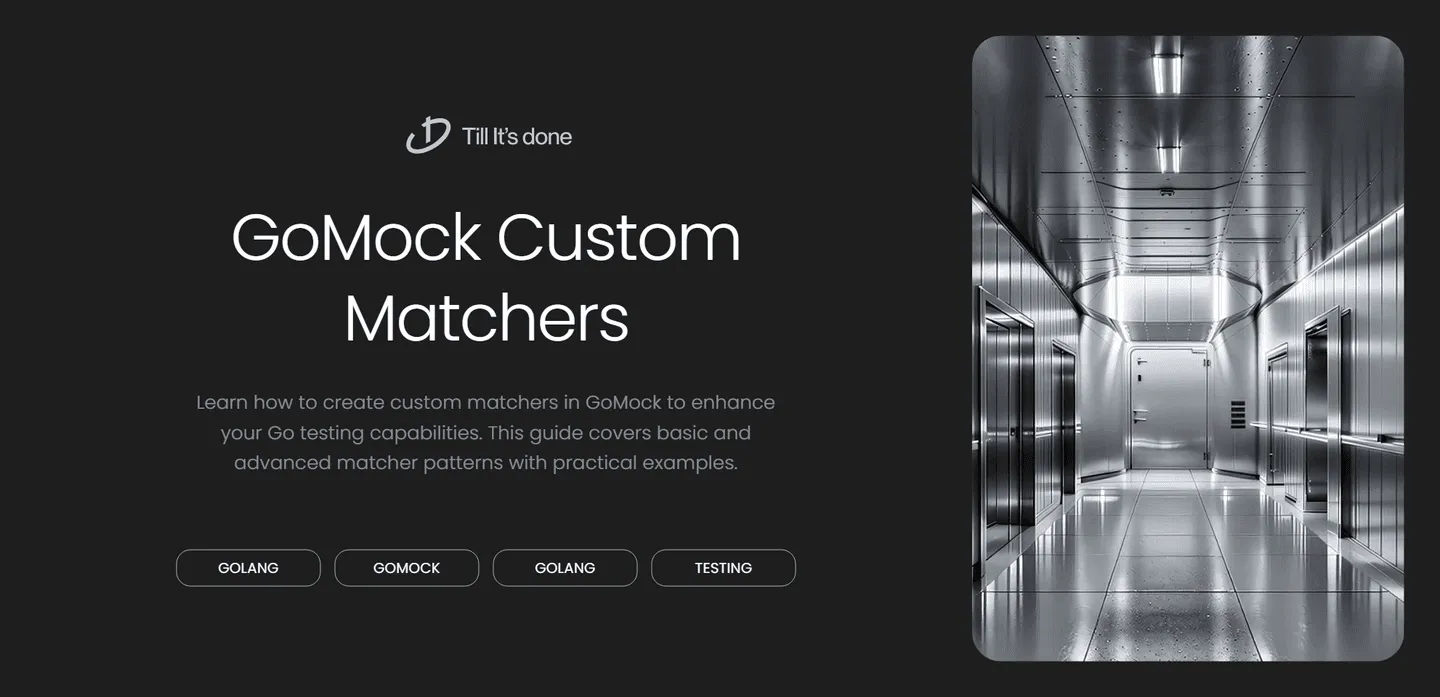- Services
- Case Studies
- Technologies
- NextJs development
- Flutter development
- NodeJs development
- ReactJs development
- About
- Contact
- Tools
- Blogs
- FAQ
Creating Custom Matchers in GoMock for Testing
This guide covers basic and advanced matcher patterns with practical examples.

Creating Custom Matchers in GoMock for Enhanced Flexibility

Testing is a crucial aspect of software development, and when it comes to Go testing, GoMock stands out as a powerful mocking framework. While GoMock provides several built-in matchers, there are situations where you need more specific matching logic. Let’s dive into creating custom matchers in GoMock to make your tests more flexible and expressive.
Understanding Custom Matchers
Custom matchers in GoMock allow you to define your own matching logic for method arguments. This becomes particularly useful when the standard matchers don’t quite fit your needs or when you want to make your tests more readable and maintainable.

Creating Your First Custom Matcher
Let’s say we’re working with a payment processing system, and we need to verify that a payment amount falls within a specific range. Instead of using multiple comparisons, we can create a custom matcher:
func IsBetween(min, max float64) gomock.Matcher { return &betweenMatcher{min, max}}
type betweenMatcher struct { min, max float64}
func (m *betweenMatcher) Matches(x interface{}) bool { amount, ok := x.(float64) if !ok { return false } return amount >= m.min && amount <= m.max}
func (m *betweenMatcher) String() string { return fmt.Sprintf("is between %v and %v", m.min, m.max)}Practical Application
Here’s how you might use this custom matcher in your tests:
func TestPaymentProcessor(t *testing.T) { ctrl := gomock.NewController(t) defer ctrl.Finish()
mockProcessor := NewMockPaymentProcessor(ctrl) mockProcessor.EXPECT(). ProcessPayment(IsBetween(100.0, 1000.0)). Return(nil)
// Test implementation}
Advanced Custom Matcher Patterns
Sometimes you might need more complex matching logic. For example, let’s create a matcher that validates a transaction object’s properties:
type TransactionMatcher struct { expectedFields map[string]interface{}}
func NewTransactionMatcher() *TransactionMatcher { return &TransactionMatcher{ expectedFields: make(map[string]interface{}), }}
func (m *TransactionMatcher) WithAmount(amount float64) *TransactionMatcher { m.expectedFields["amount"] = amount return m}
func (m *TransactionMatcher) WithCurrency(currency string) *TransactionMatcher { m.expectedFields["currency"] = currency return m}
func (m *TransactionMatcher) Matches(x interface{}) bool { tx, ok := x.(*Transaction) if !ok { return false }
// Implement matching logic return tx.Amount == m.expectedFields["amount"].(float64) && tx.Currency == m.expectedFields["currency"].(string)}
func (m *TransactionMatcher) String() string { return fmt.Sprintf("matches transaction with %v", m.expectedFields)}This approach provides a fluent interface for creating matchers and makes your tests more readable and maintainable.
Best Practices
- Keep matchers focused and single-purpose
- Provide clear error messages in the String() method
- Consider making matchers reusable across different test suites
- Document your custom matchers well
- Include error handling for type assertions
Custom matchers are a powerful tool in your testing arsenal. They help you write more expressive tests while keeping your code clean and maintainable. Don’t hesitate to create custom matchers when built-in ones don’t quite fit your needs.

 สร้างเว็บไซต์ 1 เว็บ ต้องใช้งบเท่าไหร่? เจาะลึกทุกองค์ประกอบ website development cost อยากสร้างเว็บไซต์แต่ไม่มั่นใจในเรื่องของงบประมาณ อ่านสรุปเจาะลึกตั้งแต่ดีไซน์, ฟังก์ชัน และการดูแล พร้อมตัวอย่างงบจริงจาก Till it’s done ที่แผนชัด งบไม่บานปลายแน่นอน
สร้างเว็บไซต์ 1 เว็บ ต้องใช้งบเท่าไหร่? เจาะลึกทุกองค์ประกอบ website development cost อยากสร้างเว็บไซต์แต่ไม่มั่นใจในเรื่องของงบประมาณ อ่านสรุปเจาะลึกตั้งแต่ดีไซน์, ฟังก์ชัน และการดูแล พร้อมตัวอย่างงบจริงจาก Till it’s done ที่แผนชัด งบไม่บานปลายแน่นอน  Next.js สอน 14 ขั้นตอนเบื้องต้น: สร้างโปรเจกต์แรกใน 30 นาที เริ่มต้นกับ Next.js ใน 14 ขั้นตอนเพียงแค่ 30 นาที พร้อม SSR/SSG และ API Routes ด้วยตัวอย่างโค้ดง่าย ๆ อ่านต่อเพื่อสร้างโปรเจ็กต์แรกได้ทันทีที่นี่
Next.js สอน 14 ขั้นตอนเบื้องต้น: สร้างโปรเจกต์แรกใน 30 นาที เริ่มต้นกับ Next.js ใน 14 ขั้นตอนเพียงแค่ 30 นาที พร้อม SSR/SSG และ API Routes ด้วยตัวอย่างโค้ดง่าย ๆ อ่านต่อเพื่อสร้างโปรเจ็กต์แรกได้ทันทีที่นี่  วิธีสมัคร Apple Developer Account เพื่อนำแอปขึ้น App Store ทีละขั้นตอน อยากปล่อยแอปบน App Store ระดับโลก มาอ่านคู่มือสมัคร Apple Developer Account พร้อมเคล็ดลับ TestFlight และวิธีอัปโหลดที่ง่ายในบทความเดียวนี้ได้เลย
วิธีสมัคร Apple Developer Account เพื่อนำแอปขึ้น App Store ทีละขั้นตอน อยากปล่อยแอปบน App Store ระดับโลก มาอ่านคู่มือสมัคร Apple Developer Account พร้อมเคล็ดลับ TestFlight และวิธีอัปโหลดที่ง่ายในบทความเดียวนี้ได้เลย  TypeScript Interface คืออะไร? อธิบายพร้อมวิธีใช้และข้อแตกต่างจาก Type เรียนรู้วิธีใช้ TypeScript Interface เพื่อสร้างโครงสร้างข้อมูลที่ปลอดภัยและเข้าใจง่าย พร้อมเปรียบเทียบข้อดีข้อแตกต่างกับ Type ที่คุณต้องรู้ ถูกรวมเอาไว้ในบทความนี้แล้ว
TypeScript Interface คืออะไร? อธิบายพร้อมวิธีใช้และข้อแตกต่างจาก Type เรียนรู้วิธีใช้ TypeScript Interface เพื่อสร้างโครงสร้างข้อมูลที่ปลอดภัยและเข้าใจง่าย พร้อมเปรียบเทียบข้อดีข้อแตกต่างกับ Type ที่คุณต้องรู้ ถูกรวมเอาไว้ในบทความนี้แล้ว  Material-UI (MUI) คืออะไร อยากสร้าง UI สวยงามและเป็นมืออาชีพในเวลาอันรวดเร็วใช่ไหม มาทำความรู้จักกับ Material-UI (MUI) ที่ช่วยให้คุณพัฒนาแอปพลิเคชันบน React ได้ง่ายและดูดีในทุกอุปกรณ์
Material-UI (MUI) คืออะไร อยากสร้าง UI สวยงามและเป็นมืออาชีพในเวลาอันรวดเร็วใช่ไหม มาทำความรู้จักกับ Material-UI (MUI) ที่ช่วยให้คุณพัฒนาแอปพลิเคชันบน React ได้ง่ายและดูดีในทุกอุปกรณ์  เปรียบเทียบ 3 วิธีติดตั้ง install node js บน Ubuntu: NVM vs NodeSource vs Official Repo แบบไหนดีที่สุด? เรียนรู้วิธีติดตั้ง Node.js บน Ubuntu ด้วย NVM, NodeSource หรือ Official Repo เลือกวิธีที่เหมาะกับความต้องการของคุณ พร้อมเปรียบเทียบ เพื่อการพัฒนาที่มีประสิทธิภาพ!
เปรียบเทียบ 3 วิธีติดตั้ง install node js บน Ubuntu: NVM vs NodeSource vs Official Repo แบบไหนดีที่สุด? เรียนรู้วิธีติดตั้ง Node.js บน Ubuntu ด้วย NVM, NodeSource หรือ Official Repo เลือกวิธีที่เหมาะกับความต้องการของคุณ พร้อมเปรียบเทียบ เพื่อการพัฒนาที่มีประสิทธิภาพ! พูดคุยกับซีอีโอ
We'll be right here with you every step of the way.
We'll be here, prepared to commence this promising collaboration.
Whether you're curious about features, warranties, or shopping policies, we provide comprehensive answers to assist you.


